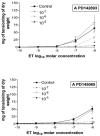Comparison of 2 endothelin-receptor antagonists on in vitro responses of equine palmar digital arterial and venous rings to endothelin-1
- PMID: 16850942
- PMCID: PMC1477928
Comparison of 2 endothelin-receptor antagonists on in vitro responses of equine palmar digital arterial and venous rings to endothelin-1
Abstract
The goals of this study were to determine the concentration-response (C-R) relationship of endothelin-1 (ET-1), compare 2 ET-receptor antagonists and determine the antagonist concentrations that block the vasomotor effects of ET-1, and compare the effectiveness of ET-1 and previously studied vasoconstrictors in equine palmar digital arterial and venous rings in vitro. Vessel rings from 8 nonlaminitic horses were placed in Tyrode's solution, 1 side fixed to the floor of an organ bath and the other side fixed to a force-displacement transducer. Two separate studies were conducted: (I) incubation with a single ET-receptor antagonist (PD142893 or PD145065 at a concentration of 10(-7), 10(-6), or 10(-5) M), followed by determination of an ET-1 C-R curve (using concentrations of 10(-10) to 10(-6) M) for medial vessel rings; and (II) comparison of ET-1 with norepinephrine and histamine (10(-10) to 10(-6) M) and comparison of contractile responses of medial and lateral vessel rings. In study I, ET-1 administration caused pronounced and sustained concentration-dependent contraction of vessel rings; these contractile responses were decreased by 10(-5) M PD142893 and were completely blocked by 10(-5) M PD145065. Venous rings had greater apparent maximum contraction in response to ET-1 than arterial rings. In study II, the relative sensitivity of norepinephrine was found to be equivalent to that of ET-1, whereas that of histamine was lower. No significant differences were observed between responses of medial versus lateral vessel rings. Thus, ET-1 is a potent vasoconstrictor of equine palmar digital arteries and veins, and the ET-receptor antagonist PD145065 is more effective than PD142893 in inhibiting these contractile effects in vitro.
Cette étude, effectuée in vitro en utilisant des anneaux vasculaires provenant de l’artère et de la veine digitale palmaire de chevaux, avait comme objectifs de déterminer la relation concentration–réponse (C–R) de l’endotheline-1 (ET-1), de comparer deux antagonistes des récepteurs à ET et déterminer les concentrations d’antagonistes qui bloquent les effets vasomoteurs d’ET-1, ainsi que de comparer l’efficacité d’ET-1 et de vasoconstricteurs préalablement étudiés. Des anneaux vasculaires provenant de huit chevaux sans boiterie ont été mis dans de la solution de Tyrode, un côté fixé au plancher d’un bain à organe et l’autre côté fixé à un transducteur de « force de déplacement ». Deux études distinctes ont été réalisées : (I) incubation avec un seul antagoniste de récepteur à ET (PD142893 ou PD145065 à une concentration de 10−7, 10−6 ou 10−5 M), suivi de la détermination de la courbe C–R d’anneaux vasculaires médiaux à ET-1 (concentrations de 10−10 à 10−6 M); et (II) comparaison d’ET-1 à la norépinéphrine et l’histamine (concentrations de 10−10 à 10−6 M) et comparaison des réponses contractiles d’anneaux vasculaires médiaux et latéraux. Dans l’étude I, l’administration d’ET-1 entraîna une contraction concentration-dépendante prononcée et soutenue des anneaux vasculaires; ces réponses contractiles étaient diminuées par 10−5 M de PD142893 et étaient complètement bloquées par 10−5 M de PD145065. Les anneaux veineux avaient une contraction maximale apparente plus grande que les anneaux artériels en réponse à ET-1. Dans l’étude II, la sensibilité relative de la norépinéphrine était équivalente à celle d’ET-1, alors que celle de l’histamine était inférieure. Aucune différence significative n’a été observée entre les réponses des anneaux vasculaires médiaux et latéraux. Ainsi, ET-1 est un vasoconstricteur puissant des artères et veines digitales palmaires de chevaux, et l’antagoniste du récepteur à ET-1 PD145065 est plus efficace que PD142893 pour inhiber ces effets contractiles in vitro.
(Traduit par Docteur Serge Messier)
Figures





Similar articles
-
Characterization and comparison of the responses of equine digital arteries and veins to endothelin-1.Am J Vet Res. 2003 Nov;64(11):1438-43. doi: 10.2460/ajvr.2003.64.1438. Am J Vet Res. 2003. PMID: 14620782
-
In vitro pharmacologic effect of two endothelin-1 antagonists on equine colonic arteries and veins.Am J Vet Res. 2001 Feb;62(2):154-9. doi: 10.2460/ajvr.2001.62.154. Am J Vet Res. 2001. PMID: 11212019
-
Comparison of the contractile and calcium-increasing properties of platelet-activating factor and endothelin-1 in the rat mesenteric artery and vein.Br J Pharmacol. 2002 Jan;135(2):433-43. doi: 10.1038/sj.bjp.0704441. Br J Pharmacol. 2002. PMID: 11815379 Free PMC article.
-
Therapeutic targets in hypertension: is there a place for antagonists of the most potent vasoconstrictors?Expert Opin Ther Targets. 2008 Mar;12(3):327-39. doi: 10.1517/14728222.12.3.327. Expert Opin Ther Targets. 2008. PMID: 18269342 Review.
-
Endothelin receptor selectivity: evidence from in vitro and pre-clinical models of scleroderma.Eur J Clin Invest. 2009 Jun;39 Suppl 2:19-26. doi: 10.1111/j.1365-2362.2009.02117.x. Eur J Clin Invest. 2009. PMID: 19335743 Review.
Cited by
-
The effect of tumour necrosis factor-α and insulin on equine digital blood vessel function in vitro.Inflamm Res. 2014 Aug;63(8):637-47. doi: 10.1007/s00011-014-0736-2. Epub 2014 Apr 24. Inflamm Res. 2014. PMID: 24764104
-
Effect of short-term hyperinsulinemia on the localization and expression of endothelin receptors A and B in lamellar tissue of the forelimbs of horses.Am J Vet Res. 2014 Apr;75(4):367-74. doi: 10.2460/ajvr.75.4.367. Am J Vet Res. 2014. PMID: 24669922 Free PMC article.
References
-
- Yanagisawa M, Kurihara H, Kimura S, Goto K, Masaki T. A novel peptide vasoconstrictor, endothelin, is produced by vascular endothelium and modulates smooth muscle Ca2+ channels. J Hypertens Suppl. 1988;6((4)):S188–S191. - PubMed
-
- Resink TJ, Hahn AW, Scott-Burden T, Powell J, Weber E, Buhler FR. Inducible endothelin mRNA expression and peptide secretion in cultured human vascular smooth muscle cells. Biochem Biophys Res Commun. 1990;168:1303–1310. - PubMed
-
- Gwathmey JK, Paige JA. Endothelin and vasoactive peptides: new cardiovascular mediators. J Vet Pharmacol Ther. 1994;17:420–425. - PubMed
-
- Rubanyi GM, Polokoff MA. Endothelins: molecular biology, biochemistry, pharmacology, physiology, and pathophysiology. Pharmacol Rev. 1994;46:325–415. - PubMed
Publication types
MeSH terms
Substances
LinkOut - more resources
Full Text Sources
